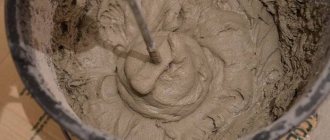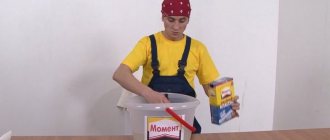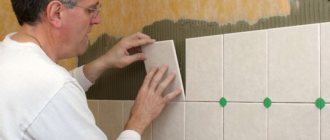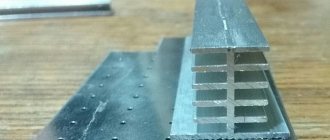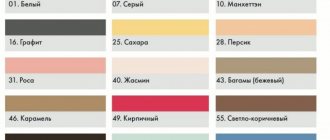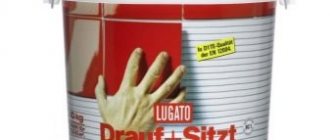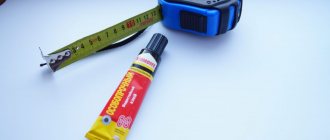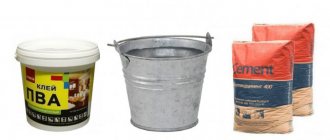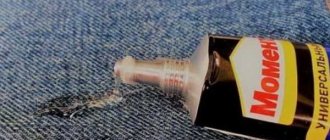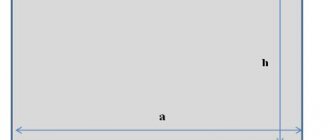The quality of finishing work, which involves laying tile material, largely depends on the chosen fastening product. To get a long-lasting result and protect the surface from the harmful effects of the environment, you need to take the choice of glue seriously. Among the reliable products we can highlight Ceresit SM 11 glue. More details about the features of the mixture and the rules for working with it will be discussed below.
Glue consumption
Many people purchase tile adhesive in larger quantities than necessary. They believe that excess consumables are better than not having enough glue. But the cost of such repairs can be many times more expensive.
Glue Ceresit SM 11
To avoid unnecessary expenses and worries, it is necessary to calculate the possible consumption of Ceresit SM-11 or SM-17 glue for gluing 1 m2 of tiles and multiply by the total area to be repaired.
Usually, no one doubts the measurements of the total area. To do this, the length (A) and width (B) of the wall or floor to be glued are measured and calculated using the formula: area equals A multiplied by B. But how much and what kind of glue is required for 1 m2 of tiles, there is no definite answer.
You can determine the quantity only if you have information about the type of glue, the size and type of individual tiles, the structure of their surfaces, as well as the material that makes up the base to which it must be glued.
Purpose of tile adhesive
When laying porcelain stoneware on the floor or walls, various building mixtures are used. There are also quite a lot of them in the Ceresit line, each of which is labeled depending on its purpose:
- primers - CT
- elasticizers - SS;
- waterproofing - CR;
- adhesive composition - CM;
- processing of tile joints - CE;
- porcelain tile repair ‒ CB.
It’s easy to get confused among such a variety of choices. At the same time, CM 11 is a universal product that is most popular. It contains high-grade cement as the basis for binding the surface and finishing material. In addition, minerals and modifying substances are added to the glue, which further improve the properties of the product.
Types of glue
In total, manufacturers produce 3 types of tile adhesive. They differ in composition and can be made of cement, epoxy resin or dispersion.
Cement Ceresite
Cement adhesive is sold in bags and contains cement as a base. When working, it must be diluted with plain water. This type of material is considered the most economical and easiest to work with. On average, when applying an adhesive thickness of about a millimeter, the consumption of Ceresit SM-11 adhesive per m2 is approximately 1 kg, with a greater thickness up to 1.9 kg.
Epoxy glue has a viscous semi-liquid consistency, completely ready for use. The shelf life after opening the container is short, so it is better not to buy too much.
Preparation of glue
The dispersion analogue consists of two components: a liquid and a catalyst, which makes it possible to enhance the properties of the glue. This is the most expensive, but also the most sustainable option. After gluing epoxy resin with a catalyst, the tiles will not fall off over time, even when exposed to an aggressive environment and sudden temperature changes.
Area of use
The described adhesive is intended for cladding non-deformable mineral substrates such as brick, plaster, concrete and cement. Surfaces that are supposed to be tiled may be in use under conditions of periodic or constant exposure to water. The glue can be used when installing a heated floor system. This adhesive composition is also actively used when laying stone and ceramic tiles, the water absorption of which is 3 percent or higher.
Tile size
The thickness of the layer between the tile and the surface to which it is glued depends on the size of the source material. The smaller the tile size, the thinner the adhesive layer can be applied. So, for tiles measuring 10x10, an adhesive layer of 1 to 1.5 mm is sufficient, and for slabs of a relatively large size (for example, 60x60), a layer of 4 to 5 mm will be required.
Laying tiles
Important! To avoid confusion about the thickness of the adhesive base, ask the seller for the size of the spatula teeth for a given size of tile. The technology of applying glue using a spatula with teeth of the required height greatly facilitates the work and allows for installation as evenly as possible, without resorting to additional devices. Remember that calculations of the consumption of Ceresit tile adhesive, based on the height of the spatula teeth, are very approximate and do not take into account the angle at which you will hold the tool while working.
CERESIT CM 11 PLUS tile adhesive for interior and adv. works, Russia (5kg)
Adhesive for tiles Ceresit CM 11 Plus for interior and exterior use and porcelain tiles for interior use
Properties
- water- and frost-resistant;
- resistant to sliding of large tiles;
- suitable for fixing porcelain stoneware tiles on floors and walls inside buildings;
- compatible with Ceresit CR 65 waterproofing;
- suitable for indoor and outdoor use;
- environmentally friendly.
Application area
Tile adhesive Ceresit SM 11 Plus is intended for fastening ceramic and stone tiles (except marble) with water absorption ≥ 3% and size up to 50x50 cm inside and outside buildings, and porcelain tiles with water absorption < 3% and size up to 50x50 cm inside buildings.
Recommended for use on walls and floors on non-deformable mineral substrates: concrete, cement screeds, cement and cement-lime plasters, etc. Suitable for installing tile cladding on a coating made of waterproofing mixture CR 65. With the addition of the elasticizer CC 83 can be used for fastening all types of tiles on coatings made from waterproofing materials CR 166 and CL 51, heated screeds, plinths, parapets, external stairs, entrances, floors of balconies and terraces, existing roofs, existing ceramic and stone cladding, deformable bases (plasterboard, gypsum board, chipboard, OSB), durable paint coatings, gypsum and anhydrite bases, lightweight, cellular and “young” (≥ 1 month) concrete, in indoor and outdoor swimming pools.
Preparing the base
The base must meet the requirements of SNiP 3.04.01-87 and have sufficient load-bearing capacity. Clean the base from dust, grease, bitumen and other substances that reduce the adhesion of the adhesive. Weak areas and peelings should be removed.
Irregularities up to 5 mm can be leveled with the same adhesive mixture at least 1 day before fixing the tiles. Unevenness greater than 5 mm should be leveled with a suitable Ceresit plaster or flooring mixture.
Cement and cement-lime plasters, cement screeds (age ≥ 28 days, humidity ≤ 4%), concrete (age ≥ 3 months, humidity ≤ 4%) – in the presence of high absorbency or a weakened surface layer, treat with ST 17 primer. On walls Smooth, dense bases, for example, made of monolithic concrete, are recommended to be treated with CT 19 Betonkontakt primer.
Waterproofing coatings made from CR 65 material must be aged from 3 to 7 days.
Atypical bases (when adding elasticizer CC 83 to the adhesive):
- gypsum plasters (humidity ≤ 1%), anhydrite screeds (humidity ≤ 0.5%) – sand, remove dust and treat with primer CT 17;
- plasterboard sheets and gypsum plasterboard, fixed in accordance with the manufacturer’s recommendations, chipboard and fiberboard with a thickness of ≥ 22 mm - treat with CT 17 primer;
- OSB thickness ≥ 22 mm – sand with coarse sandpaper and remove dust;
- lightweight and cellular concrete - remove dust and treat at least twice with CT 17 primer (dilute the primer with water 1:1 during the first application);• waterproofing coatings made from CR 166 material must be ≥ 3 days old, and from CL 51 mastic - ≥ 16 hours;
- existing tile facings - rinse with an aqueous solution of soda, then with clean water and dry;
- durable acrylic paint coatings - sand with coarse sandpaper and remove dust.
Execution of work
To prepare the mixture, take a measured amount of clean water at a temperature of +15 to +20°C (or elasticizer CC 83 diluted with water - see the table for proportions). The dry mixture is gradually added to the liquid while stirring, achieving a homogeneous mass without lumps. Mixing is done with a mixer or drill with an attachment at a rotation speed of 400–800 rpm. Then a technological pause is maintained for about 5 minutes to allow the mixture to mature and mix again. The glue is applied to the base with a smooth spatula and the comb structure is profiled with a notched spatula. The size of the teeth is selected depending on the size of the tiles (see table). For exterior work and when fastening large tiles, it is recommended to additionally apply a thin continuous layer of adhesive to the mounting surface of the tiles (“combined fastening method”). Do not soak the tiles! The tiles are laid on the glue and pressed no later than 15 minutes after its application. The position of the tiles can be adjusted within 20 (25*) minutes after installation. The adhesive contact area after pressing the tiles must be at least 65% on walls and 80% on floors.
You cannot lay tiles end to end! The width of the joints is set depending on the size of the tiles and operating conditions. It is recommended to fill cladding joints with Ceresit grouts of group CE within the time limits indicated in the table (see below). Fresh glue residues can be easily washed off with water, while dried residues can only be removed mechanically.
Recommendations
Work should be carried out in dry conditions, at air and base temperatures from +5 to +30°C and relative air humidity not higher than 80%.
Shelf life
In dry conditions, on pallets, in original undamaged paper packaging - no more than 12 months from the date of manufacture, in foil packaging no more than 18 months from the date of manufacture.
Package
Dry mixture CM 11 Plus is supplied in multilayer paper bags of 5 kg and 25 kg, as well as in a foil bag of 5 kg.
Specifications
- Composition of CM 11 Plus:
a mixture of cement, mineral fillers and polymer modifiers - Bulk density of dry mixture:
1.5 ± 0.1 kg/dm3 - mixing
water - per 25 kg of dry mixture: about 6.0 l - per 5 kg of dry mixture: about 1.2 l - Mixing proportion with elasticizer CC 83:
- per 25 kg of dry mixture: 4.0 l CC 83 + 3.0–4.0 l of water - per 5 kg of dry mixture: 0.8 l CC 83 + 0.6–0, 8 liters of water - Mobility along cone immersion, PC:
8.5 ± 1.0 cm - Consumption time:
at least 2 (1*) hours - Application temperature:
+5 to +30°C - Opening time:
about 15 minutes - Adjustment time:
about 20 (25*) minutes - Sliding of tiles:
no more than 0.5 mm - Filling joints:
- for tiles with water absorption < 3%: on walls - after 8 hours, on floors - after 16 hours - for tiles with water absorption ≥ 3%: on walls and floors - after 16 hours - Adhesion to concrete at the age of 28 days:
- for ceramic tiles with water absorption ≥ 10%: ≥ 1.0** (1.3*) MPa - for porcelain tiles with water absorption ≤ 0.5%: ≥ 0.8** (1 .3*) MPa - Frost resistance of the contact zone:
at least 100 cycles (Fкз100) - temperature :
–50 to +70°C - Flammability group:
NG (GOST 30244-94)
Approximate consumption of dry mixture CM 11 Plus and elasticizer CC 83 (if used) depending
on the size of the tile:
| Tile side length, cm | Spatula tooth size, mm | Consumption, kg/m2 | |
| CM 11 Plus | SS 83* | ||
| up to 5 | 3 | OK. 1.7 | OK. 0.27 |
| to 10 | 4 | OK. 2.0 | OK. 0.32 |
| up to 15 | 6 | OK. 2.7 | OK. 0.43 |
| up to 25 | 8 | OK. 3.6 | OK. 0.58 |
| up to 30 | 10 | OK. 4.2 | OK. 0.67 |
| up to 50 | 12 | from 5.5*** | from 0.88*** |
Notes:
- material consumption depends on the quality of base preparation and the qualifications of the work performers and may be higher than the specified values.
- With a combined application method, glue consumption increases.
- When adding elasticizer SS 83, the readiness time for filling joints increases to 72 hours.
*) – when adding elasticizer CC 83; **) – after aging in an air-dry environment; ***) – when applied using a combined method.
Tile surface
The tile material is an important factor in determining the amount of adhesive. The lowest consumption of Ceresit adhesive for tiles made of porcelain stoneware. Slightly more consumables will be required for tiles with a glazed surface, and the largest amount of glue will be needed when working with porous bases and handmade tiles.
Mixing the solution
Look carefully at the evenness of the wrong side. If the surface is not smooth, then the glue consumption will increase.
Instructions for use of Ceresit SM 11 glue
Ceresit 11, in order to obtain the best indicator of the reliability and strength of the connection between the material and the surface, requires proper execution of the work. It is important that the surface is well prepared. The stages of laying tiles with Ceresit glue will be described below.
To obtain the best indicator of the reliability and strength of the connection between the material and the surface, it requires proper execution of the work.
How to breed
The rules for diluting the composition are simple; adhering to the principle of operation, a homogeneous solution is obtained. If you add an elasticizer to the mixture, the fixation time will increase to 3 days. Dilute the glue according to the instructions:
- The required amount of the mixture is poured into the prepared container.
- Pour water at a temperature of 15 to 20 degrees, the required amount is indicated on the package.
- If required, add an elasticizer.
- Mix all the components together; you can use a construction mixer or a drill with an attachment.
- Having received a homogeneous mass, it is left for five to seven minutes.
- After the required time has passed, the adhesive mass is mixed again.
- If the mass is too thick, it is permissible to add water, but you need to calculate no more than 5 mm. per kilogram.
You should not dilute the entire mixture at once; the finished solution can dry out quickly; it is recommended that when working with material measuring 20x20 and at an average pace of work, prepare 5 kg.
Having received a homogeneous mass, it is left for five to seven minutes.
Preparing the base
Requirements for the wall and floor include levelness and reliability. During preparatory work, they begin by cleaning the surface of all types of contaminants; old finishing material should also be removed. The surface is degreased, leveled, a plaster mixture is applied, it is better to use products from the same company; manufacturers create solutions that are ideally suited to each other. If the density and strength of the base are good, then you can do without a primer. In other cases, it is necessary to prime the surfaces.
Between applying each new product, you must wait until the previous one has completely dried.
The surface is degreased, leveled, and a plaster mixture is applied.
Work process
On the vertical part you need to make markings, and also install a bar marking the 1st level of tile laying. This way the material can be prevented from slipping. Next, perform the following steps:
- You need to start applying the prepared solution immediately, using a flat spatula to apply the glue to the surface.
- Run a notched trowel over the mixture; the depth of the ribbing is determined based on the size of the material.
- There are 10-15 minutes before the solution hardens, so you should apply the tile to the surface during this time; tap the tile with a rubber hammer.
- The area covered by the tile material with the solution should occupy 60-80%.
- They also finish the entire wall, leaving a distance of 1-5 mm between the tiles; it is convenient to use cross-shaped dividers to maintain evenness of the installation.
- When excess glue protrudes on the front side, they are immediately removed with a rubber spatula and wiped with a damp cloth.
- The glue should dry for 20-36 hours, after which you can carefully walk on the floor tiles.
You need to start applying the prepared solution immediately, using a flat spatula to apply the glue to the surface.
Drying time
How long it takes for CM 11 glue to dry is affected by humidity and temperature indicators. The norm is +20 degrees and 60% humidity. At low temperatures plus high humidity, drying will take longer. The solution begins to harden in the container after 3-4 hours, setting occurs in 15-25 minutes. It dries completely and gains final strength in 7-11 days.
How long it takes for CM 11 glue to dry is affected by humidity and temperature indicators.
Laying surface
Ideally, tiling is best done on a leveled surface without roughness, cracks, strong differences and without a porous structure. In this case, glue consumption will be minimal. But, if you do not plan to bring the wall or floor to a level state, it is better to purchase glue with a special leveling compound. In this case, the adhesive solution performs not only the function of adhesion. Remember that the more porous the surface structure, the more glue it will absorb.
Additional properties
It is important to note that glue can be applied to a plastered surface and a cement screed, after each of which has been formed 28 days. As for concrete foundations, work on such surfaces can begin 90 days after completion of the work. In order not to encounter problems during operation, you should not begin manipulations to finish deformable bases. This adhesive composition is also incompatible with products whose water absorption is less than 1%. If there is a need to lay tiles in rooms with high humidity, such as showers and bathrooms, the adhesive mixture “Ceresit CM 11”, the technical characteristics of which are presented in the article, can only be used subject to periodic increases in humidity, as well as the presence of intensive ventilation. It is important to properly prepare foundations that have large cracks and potholes. The master must seal and level the surface using plaster or mineral putty.
Variety of Ceresit adhesives
A series of tile mortars from the Ceresit company contains compositions for both interior and exterior use. There are universal dry mixes and specialized formulations. They all have different areas of use, to determine which you just need to look at the labeling.
- SM - dry mix for ceramic tiles. It has good adhesive properties to brickwork and concrete.
- SV - for repairing individual parts of the cladding.
- ST - compositions for external use, thermal insulation work.
Compositions of the SM brand are used when installing tiles, mosaics, and porcelain tiles. There are varieties for interior and exterior use. Moisture-resistant compounds are used in rooms with high humidity. This is an elastic composition that reliably attaches the finish even in places with vibration loads, on surfaces prone to shrinkage. The CM series includes adhesives for large tiles, marble, facade cladding and clinker.
Popular mixtures of the ST series:
- ST 84 is a polyurethane solution used to glue polystyrene foam during external thermal insulation work;
- ST 190 is a plaster-adhesive agent used to glue mineral wool; it is also applied as a base plaster when insulating facades;
- ST 85 - polystyrene foam boards are plastered inside and outside the building.
The SV series is represented by acrylic-based mounting adhesives in aerosol form. They are used inside and outside the building.
For all series, only tiles or insulation are glued; for other coatings or materials, Henkel produces specialized compounds. Any product has a certificate of conformity, which confirms the high quality of the product.
Specifications
| Characteristic | Meaning | |||||||
| SM 9 | SM 11 | SM 12 | SM 14 | SM 16 | SM 17 | SM 115 | SM 117 | |
| Proportions for dilution, liters per 25 kg | 5 | 6 (4 l CC 83 and 2 l water*) | 6 | 7,5-8 | — For walls 8.5-9 — For floors 9-9.5 | 6,75-7,5 (2 l SS 83 and 5.5 water*) | 7-8 (2 l SS 83 and 6 water*) | |
| Mixture lifetime, h | At least 2 | 1,5-2 | 2 (1,5*) | From 2 | From 2 (1*) | From 2 (1.5*) | ||
| Conditions of use | Base and air temperature from +5 to +30, air humidity no more than 80% | |||||||
| Operating time, min | From 10 | 15-20 | From 20 | From 25 | From 30 | From 20 (15*) | From 20 | |
| Tile adjustment time, min | From 15 | From 25 | From 30 | From 20 | From 25 | From 30 | From 25 | From 15 |
| Grind the seams through, h | 48 | 24 (72*) | 24 (48*) | 24 | 24 (48*) | |||
| Sliding of tiles, mm | No more than 0.5 | |||||||
| Adhesion to concrete after 28 days, MPa | >0,5 | >0,8 (1,3*) | >1 (1,3) | >0,8 | >1 | >1,3 | >0,8 (1,1*) | >1 |
| Frost resistance, cycles | Minimum 50 | From 100 | ||||||
| Operating temperature, °C | No more than 50 | -50 to +70 | From -30 to +70 | -50 to +70 | ||||
| Flammability | Incombustible | Incombustible | Incombustible | |||||
| Packaging, bags | 25 kg | 5 and 25 kg | 25 kg | |||||
* - when adding an elasticizer.
How does the drying time of tile adhesive depend on environmental conditions?
Like all solutions, ceramic tile adhesive is also dependent on environmental conditions. First of all, its drying time, in addition to standard values, depends on:
- air temperature – optimally 15-25ᵒC;
- humidity – optimally 50-80%;
- type of adhesive composition;
- water absorption of the treated surface;
- thickness of the applied layer;
- the presence of special additives in the composition, including those that accelerate or, conversely, slow down the process of setting and drying of the glue.
Ceresit CM 11 is the main favorite of tile masters
Despite the abundance and wide range of adhesive compositions for tiles, Ceresit CM 11 has virtually no competitors in terms of popularity. And there are quite logical and reasoned justifications for this.
First of all, you should pay attention that it can be used both indoors and outdoors, because it is moisture-resistant and frost-resistant. However, if you need to glue porcelain tiles, then the glue is suitable only for interior work.
But using, in fact, universal adhesive Ceresit CM 11, you should take into account the water absorption of the tile, which should be from 3%, as well as the size - optimally if it is up to 40x40 cm. For porcelain tiles there are slightly different requirements: water absorption - no higher than 3 %, due to the generally large size of the material.
This tile adhesive is a suitable choice for indoor or outdoor surfaces (porch, terrace, balcony) with low or medium traffic intensity, and for this reason it has no competitors in finishing houses or apartments.
In cases where it is necessary to improve or change some of the characteristics of Ceresit CM 11 adhesive, additives are used - for example, if you use a special elasticizer CC83, then the water absorption of the tile will no longer have virtually any significance.
